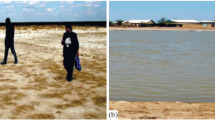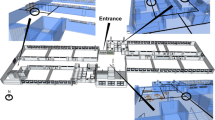Abstract
Halotolerant and halophilic microorganisms may be expected to be present on the external walls of buildings, especially in dry and/or hot climates. They have been detected in Europe in various molecular biological studies. Using plating on specific salt-supplemented medium (10 and 15%), bacteria and fungi were detected in winter, spring and summer months on the discoloured external walls of 5 historic buildings in Porto Alegre, South Brazil. Microbial biodiversity in the samples was calculated using the Simpson Index. Halotolerant non-phototroph diversity was highest in the winter (September), when environmental conditions are less extreme. Some collections yielded organisms that grew on media with 15% added salt; diversity in this case was lower. Frequently, and in all winter collections, only one type of microorganism grew; this was a brown-pigmented fungus, probable genus Cladosporium. Greater diversity was found at 15% salt in 2 collections made in the summer month of January. It is suggested that this results from the selection of organisms able to resist the more extreme conditions of high temperature and lower relative humidity.
Similar content being viewed by others
References
Cattelan AJ, Vidor C (1990) Sistemas de cultura e a população microbiana do solo. Revista Brasileira de Ciência do Solo 14:125–132
Crispim CA, Gaylarde CC, Gaylarde PM (2004) Biofilms on church walls in Porto Alegre, RS, Brazil, with special attention to cyanobacteria. Int Biodeterior Biodegradation 54:121–124
Flores M, Lorenzo J, Gómez-Alarcón G (1997) Algae and bacteria on historic monuments at Alcala de Henares, Spain. Int Biodeterior Biodegradation 40:241–246
Gaylarde CC, Morton LHG (1999) Deteriogenic biofilms on buildings and their control: a review. Biofouling 14:59–74
Gaylarde CC, Morton LHG (2002) Biodeterioration of mineral materials. In: Bitton G (ed) Encyclopedia of environmental microbiology.Wiley, NY, vol. 2, pp 516–527. ISBN 0471360473
Giovannoni SJ, Brithschgi TB, Moyer CL, Field KG (1990) Genetic diversity in Sargasso Sea bacterioplankton. Nature 245:60–63
Gunde-Cimerman AN, Zalar BP, de Hoog GS, Plemenitas DA (2000) Hypersaline waters in salterns–natural ecological niches for halophilic black yeasts. FEMS Microbiol Ecol 32:235–240
Gurtner C, Heyrman J, Lubitz W, Swings J, Rölleke S (2000) Comparative analyses of the bacterial diversity on two different biodeteriorated wall painting by DGGE and 16S rDNA sequence analysis. Int Biodeterior Biodegradation 46:229–239
Heyrman J, Swings J (2001) 16S rDNA Sequence analysis of bacterial isolates from biodeteriorated mural paintings in the Servilia tomb (Necropolis of Carmona, Seville, Spain). Syst Appl Microbiol 24:417–422
Kiel G, Gaylarde C (2006) Bacterial diversity in biofilms on external surfaces of historic buildings in Porto Alegre. World J Microbiol Biotechnol 22:293–297
Kushner DJ (1978) Life in high salt and solute concentrations: halophilic bacteria. In: Kushner DJ (ed) Microbial life in extreme environments. Academic Press, London, pp 317–368. ISBN 0124302505
Meira ALG (2001) O Passado no Futuro da Cidade – Políticas Públicas e Participação dos Cidadãos na Preservação do Patrimônio Cultural de Porto Alegre. M.Sc. Programa de Pós-Graduação em Planejamento urbano e Regional, Faculdade de Arquitetura, Universidade Federal do Rio Grande do Sul, Porto Alegre, Brasil
Nica D, Davis JL, Kirby L, Zuo G, Roberts DJ (2000) Isolation and characterization of microorganisms involved in the biodeterioration of concrete in sewers. Int Biodeterior Biodegradation 46:61–68
Piñar P, Ramos C, Rölleke S, Schabereiter-Gurtner C, Vybiral D, Lubitz W, Denner EBM (2001) Detection of indigenous Halobacillus populations in damaged ancient wall paintings and building materials: molecular monitoring and cultivation. Appl Environ Microbiol 67:4891–4895
Saiz-Jimenez C, Laiz L, (2000) Occurrence of halotolerant/halophilic bacterial communities in deteriorated monuments. Int Biodeterior Biodegradation 46:319–326
Shirakawa MA, Gaylarde CC, Gaylarde PM, John V, Gambale V (2002) Fungal colonization and succession on newly painted buildings and the effect of biocide. FEMS Microbiol Ecol 39:165–173
Author information
Authors and Affiliations
Corresponding author
Rights and permissions
About this article
Cite this article
Kiel, G., Gaylarde, C.C. Diversity of salt-tolerant culturable aerobic microorganisms on historic buildings in Southern Brazil. World J Microbiol Biotechnol 23, 363–366 (2007). https://doi.org/10.1007/s11274-006-9232-3
Received:
Accepted:
Published:
Issue Date:
DOI: https://doi.org/10.1007/s11274-006-9232-3




